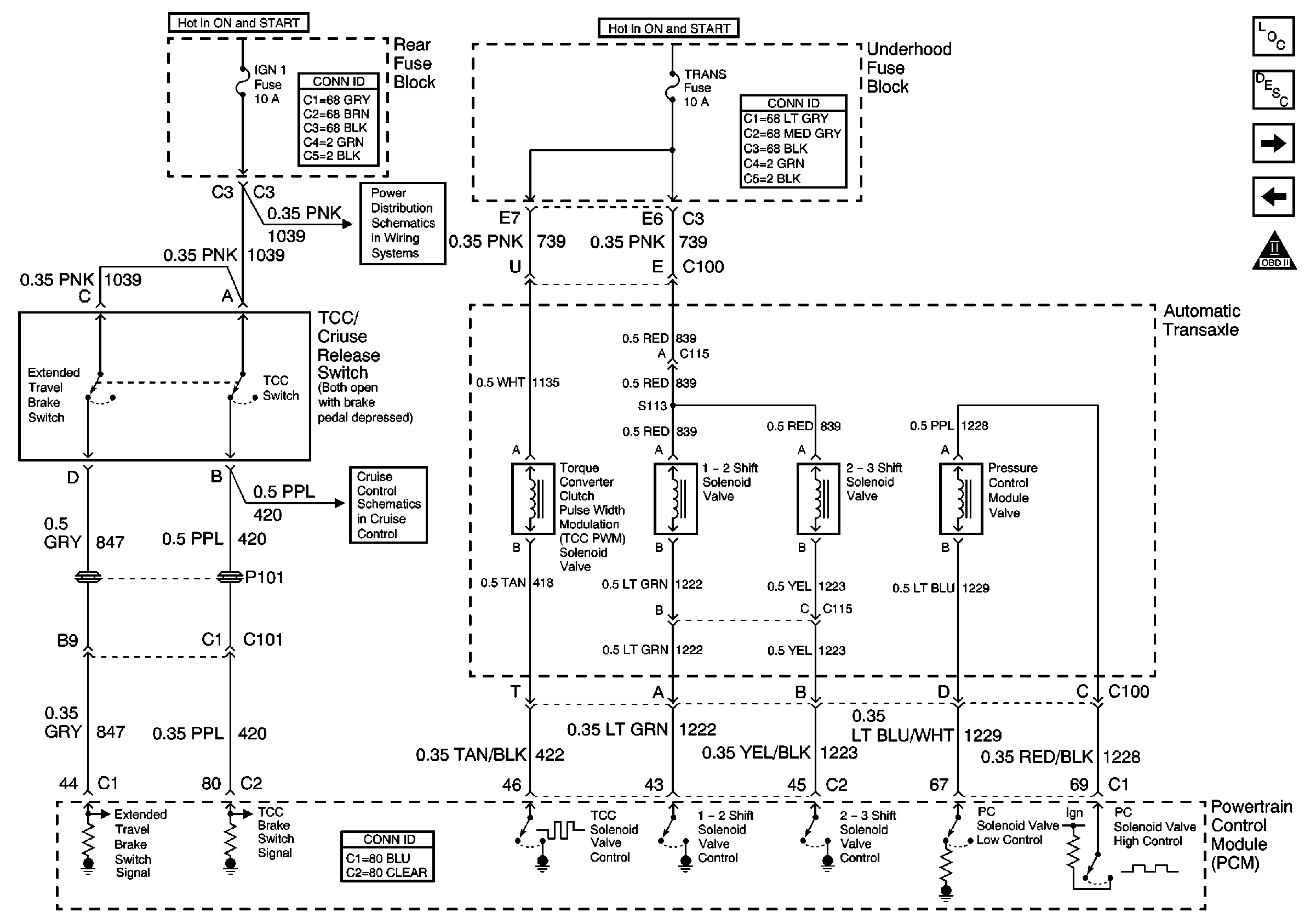Circuit Description
This diagnostic test functions on the assumption that a sudden decrease in the non-drive (rear) wheel speed must be caused by a brake application. The non-drive wheel speed and the stop lamp switch status are supplied to the powertrain control module (PCM) through the serial data from the electronic brake and traction control module (EBCM). If there is a 9.6 km/h (6 mph) or more decrease of non-drive wheel speed in 0.4 second, and a transition of the torque converter clutch (TCC) contacts at the TCC brake switch or stop lamp switch without a transition of the extended travel contacts of the TCC brake, diagnostic trouble code (DTC) P1575 is set.
Conditions for Running the DTC
| • | DTC P1574 is not set. |
| • | The traction control (TC) and antilock brake systems (ABS) have not failed. |
| • | The traction control and antilock brake systems are not active. |
| • | The non-drive wheel speed goes above 33.8 km/h (20 mph) and then does not go below 6.76 km/h (4 mph). |
Conditions for Setting the DTC
A 9.6 km/h (6 mph) or more decrease in non-drive wheel speed in 0.4 second and TCC brake switch or Stop/BTSI/Cruise brake switch indicating brakes applied and no transition is noticed in the extended travel contacts of the TCC brake switch indicating brakes applied.
Action Taken When the DTC Sets
| • | The control module stores the DTC information into memory when the diagnostic runs and fails. |
| • | The malfunction indicator lamp (MIL) will not illuminate. |
| • | The control module records the operating conditions at the time the diagnostic fails. The control module stores this information in the Failure Records. |
| • | The driver information center, if equipped, may display a message. |
Conditions for Clearing the DTC
| • | A current DTC Last Test Failed clears when the diagnostic runs and passes. |
| • | A history DTC clears after 40 consecutive warm-up cycles, if no failures are reported by this or any other non-emission related diagnostic. |
| • | Clear the DTC with a scan tool. |
Diagnostic Aids
If the condition is intermittent, refer to Intermittent Conditions in Symptoms.
Step | Action | Yes | No | ||||||
|---|---|---|---|---|---|---|---|---|---|
Schematic Reference:
| |||||||||
1 | Did you perform the Diagnostic System Check-Engine Controls? | Go to Step 2 | |||||||
2 |
Does the scan tool display indicate Released? | Go to Step 3 | Go to Step 6 | ||||||
3 | Depress the brake pedal approximately half-way. Does the scan tool display indicate Applied? | Go to Intermittent Conditions | Go to Step 4 | ||||||
4 | Disconnect the extended travel brake switch connector. Does the scan tool display indicate Applied? | Go to Step 14 | Go to Step 5 | ||||||
5 | Test for a short to voltage on the extended travel brake switch signal circuit. Refer to Testing for a Short to Voltage in Wiring Systems. Did you find and correct the condition? | Go to Step 17 | Go to Step 16 | ||||||
6 | With a scan tool, observe the TCC brake switch display. Does the scan tool display indicate Released? | Go to Step 7 | Go to Step 11 | ||||||
7 |
Did you find and correct the condition? | Go to Step 17 | Go to Step 8 | ||||||
8 |
Does the scan tool indicate Released? | Go to Step 9 | Go to Step 10 | ||||||
9 | Inspect for poor connections at the TCC/extended travel brake switch. Refer to Testing for Intermittent Conditions and Poor Connections in Wiring Systems. Did you find and correct the condition? | Go to Step 17 | Go to Step 14 | ||||||
10 | Test for the following conditions:
Did you find and correct the condition? | Go to Step 17 | Go to Step 16 | ||||||
11 | Inspect the IGN 1 fuse for an open circuit. Is the fuse open? | Go to Step 12 | Go to Step 13 | ||||||
12 |
Did you find and correct the condition? | Go to Step 17 | Go to Intermittent Conditions | ||||||
13 | Test for an open in the ignition 1 voltage circuit to the TCC/extended travel brake switch assembly. Did you find and correct the condition? | Go to Step 17 | Go to Step 14 | ||||||
14 | Test for proper TCC/extended travel brake switch adjustment. Did the switch require adjustment? | Go to Step 17 | Go to Step 15 | ||||||
15 | Replace the TCC/extended travel brake switch. Is the action complete? | Go to Step 17 | -- | ||||||
16 | Replace the PCM. Refer to Powertrain Control Module Replacement . Is the action complete? | Go to Step 17 | -- | ||||||
17 |
Does the scan tool indicate that this test passed? | Go to Step 18 | Go to Step 2 | ||||||
18 | With a scan tool, observe the stored information, Capture Info. Does the scan tool display any DTCs that you have not diagnosed? | System OK | |||||||

